The Impact of COVID-19 on Health of Black and Ethnic Minorities
VerifiedAdded on 2022/05/02
|20
|5602
|58
Report
AI Summary
This report examines the disproportionate impact of the COVID-19 pandemic on the health of Black and ethnic minority groups in London. It explores the factors contributing to these disparities, including deprivation, housing conditions, and educational attainment. The report delves into the research question of how different ethnic groups were affected by the coronavirus, analyzing health outcomes such as increased mortality rates, hospitalizations, and the need for intensive care. It investigates the role of social determinants of health, such as access to healthcare and the impact of prejudice and racism. The study utilizes a phenomenological approach to understand the experiences of these communities. The report concludes with recommendations for addressing the inequalities highlighted, emphasizing the need for improved healthcare access and targeted interventions to mitigate the adverse effects of the pandemic on vulnerable populations.
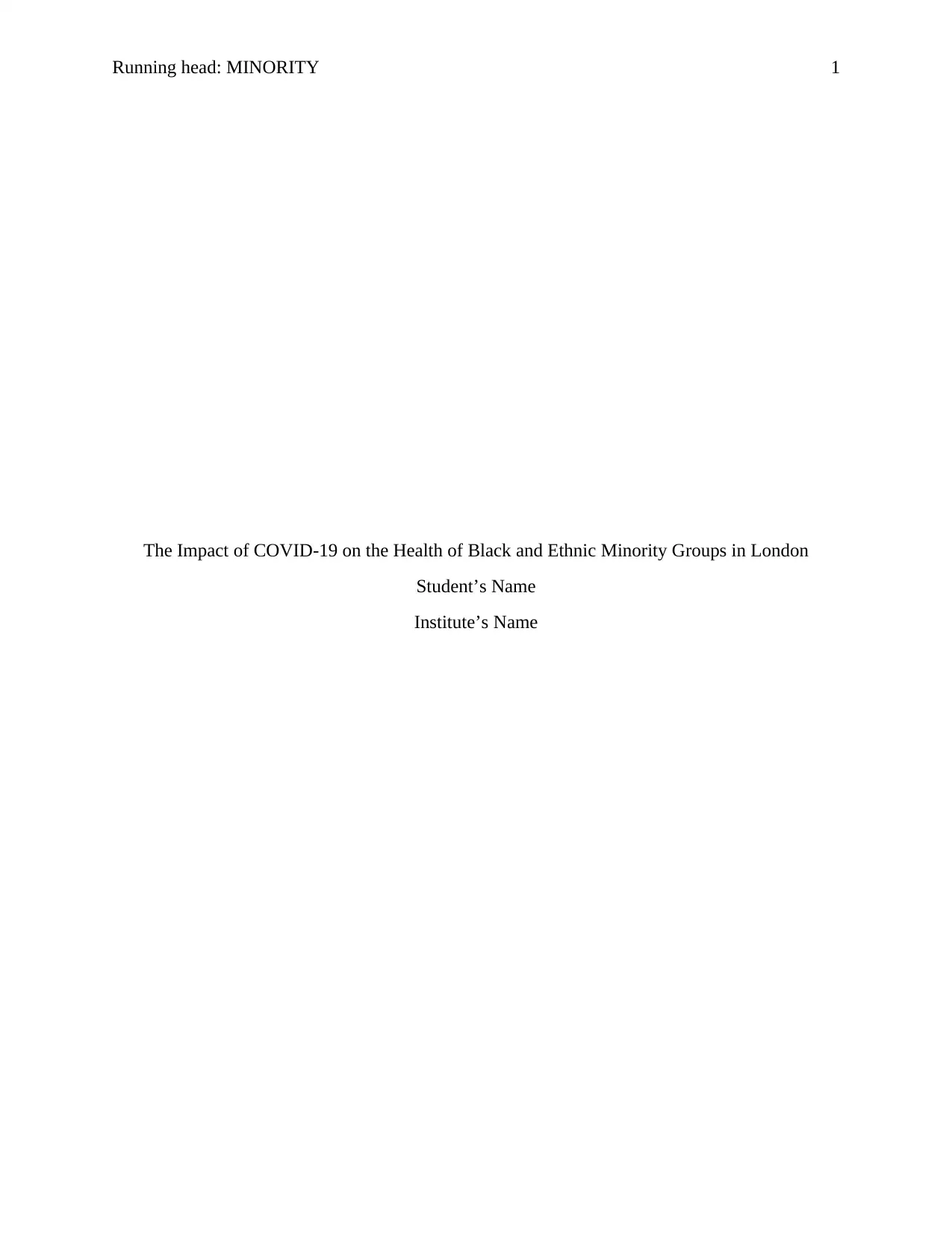
Running head: MINORITY 1
The Impact of COVID-19 on the Health of Black and Ethnic Minority Groups in London
Student’s Name
Institute’s Name
The Impact of COVID-19 on the Health of Black and Ethnic Minority Groups in London
Student’s Name
Institute’s Name
Paraphrase This Document
Need a fresh take? Get an instant paraphrase of this document with our AI Paraphraser
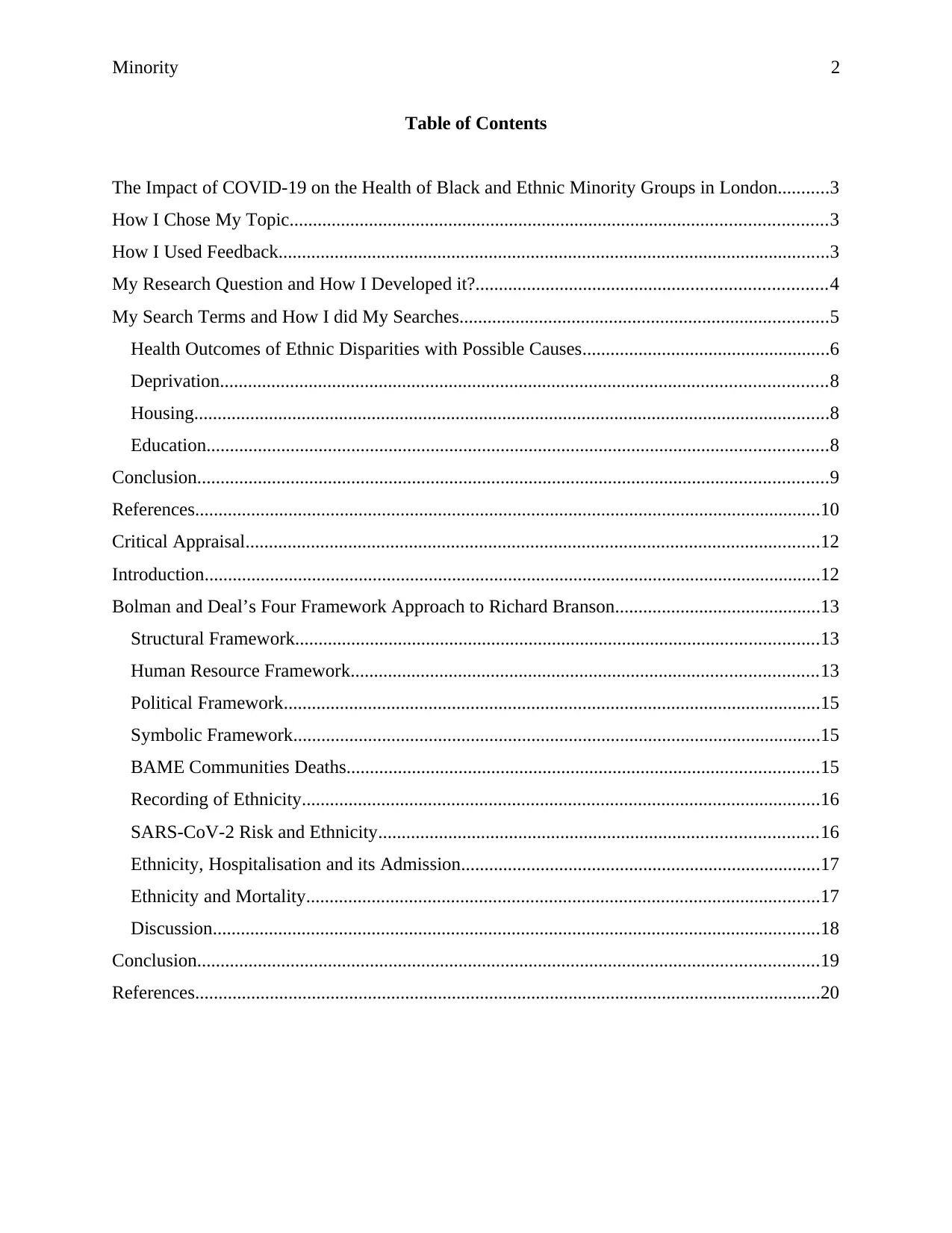
Minority 2
Table of Contents
The Impact of COVID-19 on the Health of Black and Ethnic Minority Groups in London...........3
How I Chose My Topic...................................................................................................................3
How I Used Feedback......................................................................................................................3
My Research Question and How I Developed it?...........................................................................4
My Search Terms and How I did My Searches...............................................................................5
Health Outcomes of Ethnic Disparities with Possible Causes.....................................................6
Deprivation..................................................................................................................................8
Housing........................................................................................................................................8
Education.....................................................................................................................................8
Conclusion.......................................................................................................................................9
References......................................................................................................................................10
Critical Appraisal...........................................................................................................................12
Introduction....................................................................................................................................12
Bolman and Deal’s Four Framework Approach to Richard Branson............................................13
Structural Framework................................................................................................................13
Human Resource Framework....................................................................................................13
Political Framework...................................................................................................................15
Symbolic Framework.................................................................................................................15
BAME Communities Deaths.....................................................................................................15
Recording of Ethnicity...............................................................................................................16
SARS-CoV-2 Risk and Ethnicity..............................................................................................16
Ethnicity, Hospitalisation and its Admission.............................................................................17
Ethnicity and Mortality..............................................................................................................17
Discussion..................................................................................................................................18
Conclusion.....................................................................................................................................19
References......................................................................................................................................20
Table of Contents
The Impact of COVID-19 on the Health of Black and Ethnic Minority Groups in London...........3
How I Chose My Topic...................................................................................................................3
How I Used Feedback......................................................................................................................3
My Research Question and How I Developed it?...........................................................................4
My Search Terms and How I did My Searches...............................................................................5
Health Outcomes of Ethnic Disparities with Possible Causes.....................................................6
Deprivation..................................................................................................................................8
Housing........................................................................................................................................8
Education.....................................................................................................................................8
Conclusion.......................................................................................................................................9
References......................................................................................................................................10
Critical Appraisal...........................................................................................................................12
Introduction....................................................................................................................................12
Bolman and Deal’s Four Framework Approach to Richard Branson............................................13
Structural Framework................................................................................................................13
Human Resource Framework....................................................................................................13
Political Framework...................................................................................................................15
Symbolic Framework.................................................................................................................15
BAME Communities Deaths.....................................................................................................15
Recording of Ethnicity...............................................................................................................16
SARS-CoV-2 Risk and Ethnicity..............................................................................................16
Ethnicity, Hospitalisation and its Admission.............................................................................17
Ethnicity and Mortality..............................................................................................................17
Discussion..................................................................................................................................18
Conclusion.....................................................................................................................................19
References......................................................................................................................................20
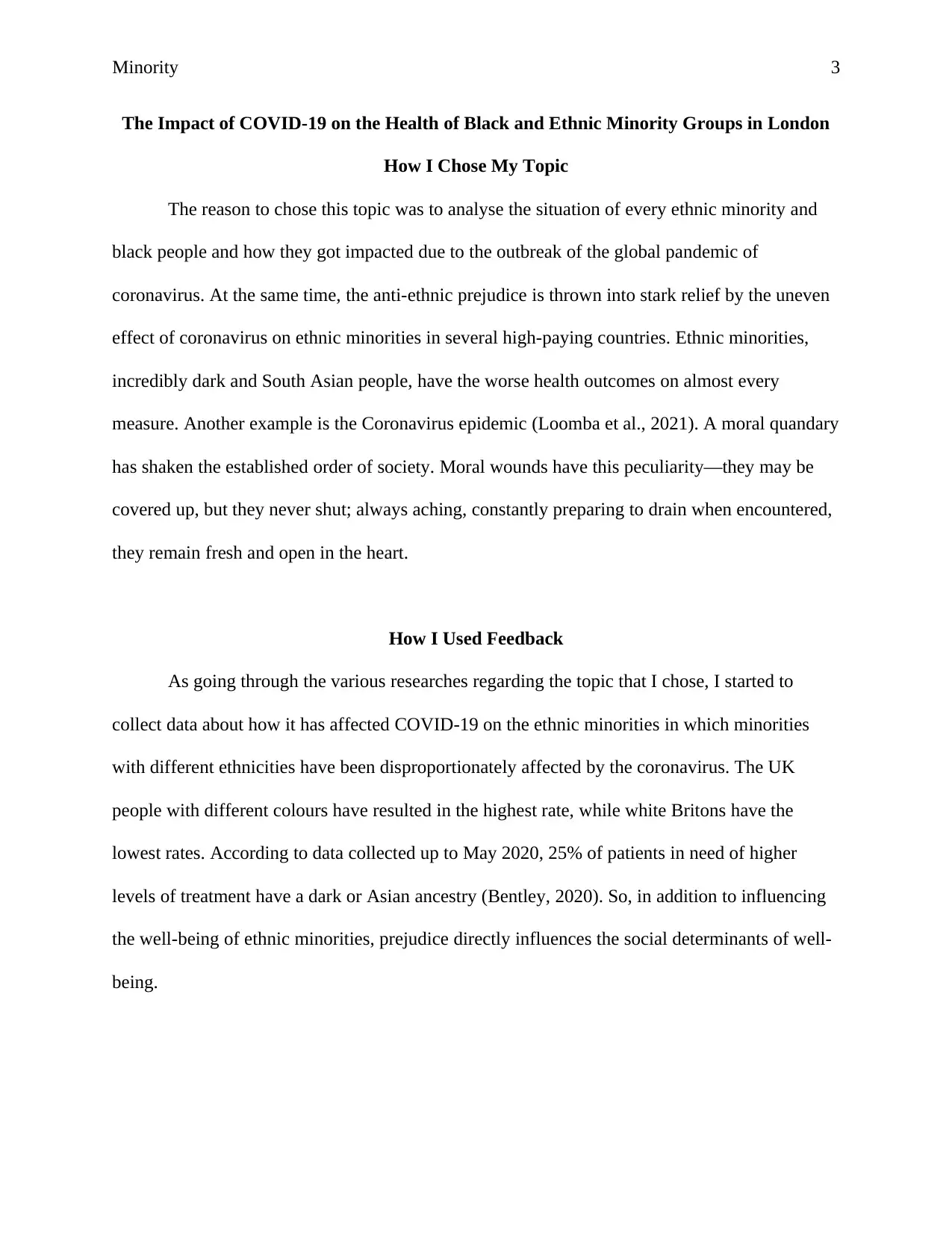
Minority 3
The Impact of COVID-19 on the Health of Black and Ethnic Minority Groups in London
How I Chose My Topic
The reason to chose this topic was to analyse the situation of every ethnic minority and
black people and how they got impacted due to the outbreak of the global pandemic of
coronavirus. At the same time, the anti-ethnic prejudice is thrown into stark relief by the uneven
effect of coronavirus on ethnic minorities in several high-paying countries. Ethnic minorities,
incredibly dark and South Asian people, have the worse health outcomes on almost every
measure. Another example is the Coronavirus epidemic (Loomba et al., 2021). A moral quandary
has shaken the established order of society. Moral wounds have this peculiarity—they may be
covered up, but they never shut; always aching, constantly preparing to drain when encountered,
they remain fresh and open in the heart.
How I Used Feedback
As going through the various researches regarding the topic that I chose, I started to
collect data about how it has affected COVID-19 on the ethnic minorities in which minorities
with different ethnicities have been disproportionately affected by the coronavirus. The UK
people with different colours have resulted in the highest rate, while white Britons have the
lowest rates. According to data collected up to May 2020, 25% of patients in need of higher
levels of treatment have a dark or Asian ancestry (Bentley, 2020). So, in addition to influencing
the well-being of ethnic minorities, prejudice directly influences the social determinants of well-
being.
The Impact of COVID-19 on the Health of Black and Ethnic Minority Groups in London
How I Chose My Topic
The reason to chose this topic was to analyse the situation of every ethnic minority and
black people and how they got impacted due to the outbreak of the global pandemic of
coronavirus. At the same time, the anti-ethnic prejudice is thrown into stark relief by the uneven
effect of coronavirus on ethnic minorities in several high-paying countries. Ethnic minorities,
incredibly dark and South Asian people, have the worse health outcomes on almost every
measure. Another example is the Coronavirus epidemic (Loomba et al., 2021). A moral quandary
has shaken the established order of society. Moral wounds have this peculiarity—they may be
covered up, but they never shut; always aching, constantly preparing to drain when encountered,
they remain fresh and open in the heart.
How I Used Feedback
As going through the various researches regarding the topic that I chose, I started to
collect data about how it has affected COVID-19 on the ethnic minorities in which minorities
with different ethnicities have been disproportionately affected by the coronavirus. The UK
people with different colours have resulted in the highest rate, while white Britons have the
lowest rates. According to data collected up to May 2020, 25% of patients in need of higher
levels of treatment have a dark or Asian ancestry (Bentley, 2020). So, in addition to influencing
the well-being of ethnic minorities, prejudice directly influences the social determinants of well-
being.
⊘ This is a preview!⊘
Do you want full access?
Subscribe today to unlock all pages.

Trusted by 1+ million students worldwide
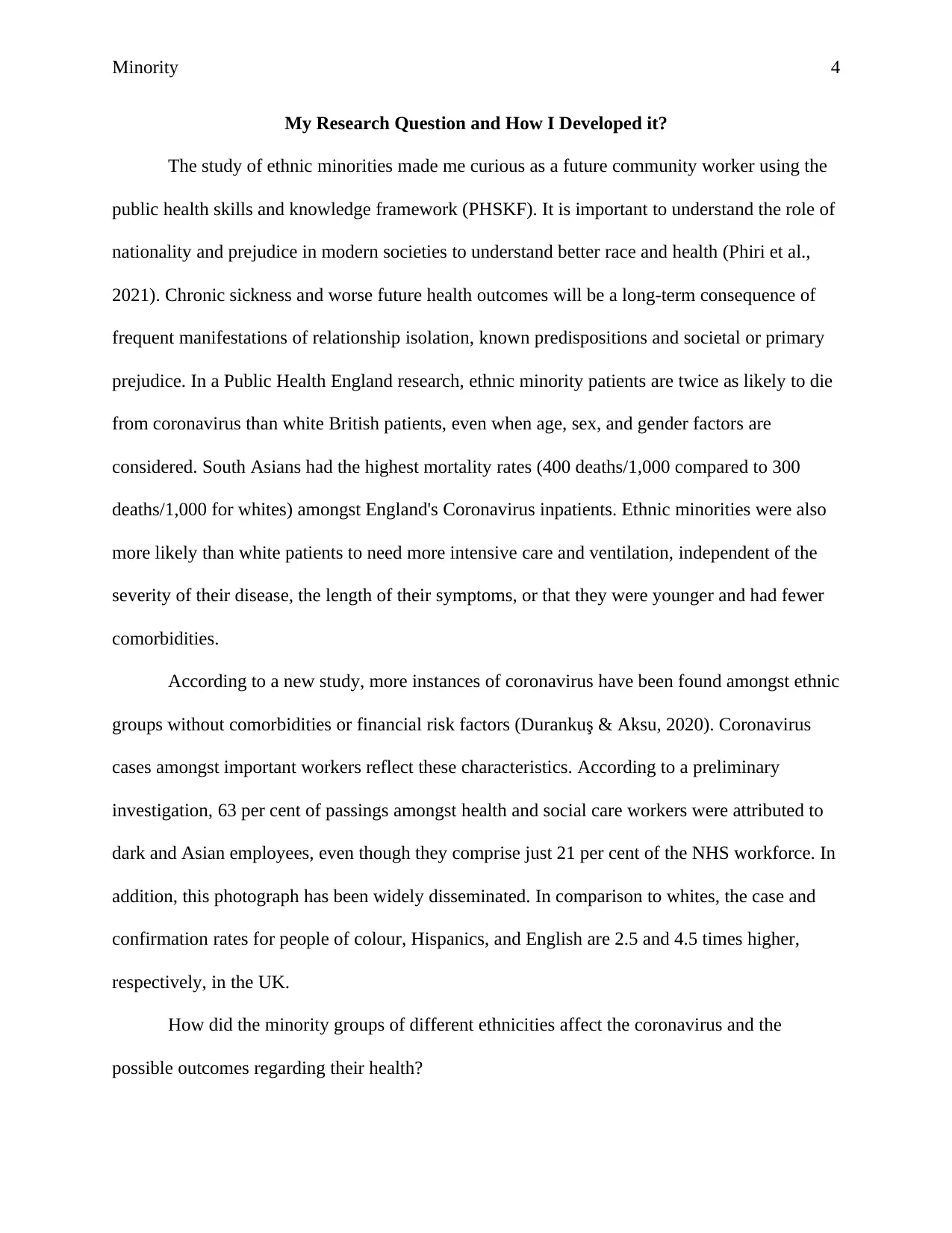
Minority 4
My Research Question and How I Developed it?
The study of ethnic minorities made me curious as a future community worker using the
public health skills and knowledge framework (PHSKF). It is important to understand the role of
nationality and prejudice in modern societies to understand better race and health (Phiri et al.,
2021). Chronic sickness and worse future health outcomes will be a long-term consequence of
frequent manifestations of relationship isolation, known predispositions and societal or primary
prejudice. In a Public Health England research, ethnic minority patients are twice as likely to die
from coronavirus than white British patients, even when age, sex, and gender factors are
considered. South Asians had the highest mortality rates (400 deaths/1,000 compared to 300
deaths/1,000 for whites) amongst England's Coronavirus inpatients. Ethnic minorities were also
more likely than white patients to need more intensive care and ventilation, independent of the
severity of their disease, the length of their symptoms, or that they were younger and had fewer
comorbidities.
According to a new study, more instances of coronavirus have been found amongst ethnic
groups without comorbidities or financial risk factors (Durankuş & Aksu, 2020). Coronavirus
cases amongst important workers reflect these characteristics. According to a preliminary
investigation, 63 per cent of passings amongst health and social care workers were attributed to
dark and Asian employees, even though they comprise just 21 per cent of the NHS workforce. In
addition, this photograph has been widely disseminated. In comparison to whites, the case and
confirmation rates for people of colour, Hispanics, and English are 2.5 and 4.5 times higher,
respectively, in the UK.
How did the minority groups of different ethnicities affect the coronavirus and the
possible outcomes regarding their health?
My Research Question and How I Developed it?
The study of ethnic minorities made me curious as a future community worker using the
public health skills and knowledge framework (PHSKF). It is important to understand the role of
nationality and prejudice in modern societies to understand better race and health (Phiri et al.,
2021). Chronic sickness and worse future health outcomes will be a long-term consequence of
frequent manifestations of relationship isolation, known predispositions and societal or primary
prejudice. In a Public Health England research, ethnic minority patients are twice as likely to die
from coronavirus than white British patients, even when age, sex, and gender factors are
considered. South Asians had the highest mortality rates (400 deaths/1,000 compared to 300
deaths/1,000 for whites) amongst England's Coronavirus inpatients. Ethnic minorities were also
more likely than white patients to need more intensive care and ventilation, independent of the
severity of their disease, the length of their symptoms, or that they were younger and had fewer
comorbidities.
According to a new study, more instances of coronavirus have been found amongst ethnic
groups without comorbidities or financial risk factors (Durankuş & Aksu, 2020). Coronavirus
cases amongst important workers reflect these characteristics. According to a preliminary
investigation, 63 per cent of passings amongst health and social care workers were attributed to
dark and Asian employees, even though they comprise just 21 per cent of the NHS workforce. In
addition, this photograph has been widely disseminated. In comparison to whites, the case and
confirmation rates for people of colour, Hispanics, and English are 2.5 and 4.5 times higher,
respectively, in the UK.
How did the minority groups of different ethnicities affect the coronavirus and the
possible outcomes regarding their health?
Paraphrase This Document
Need a fresh take? Get an instant paraphrase of this document with our AI Paraphraser
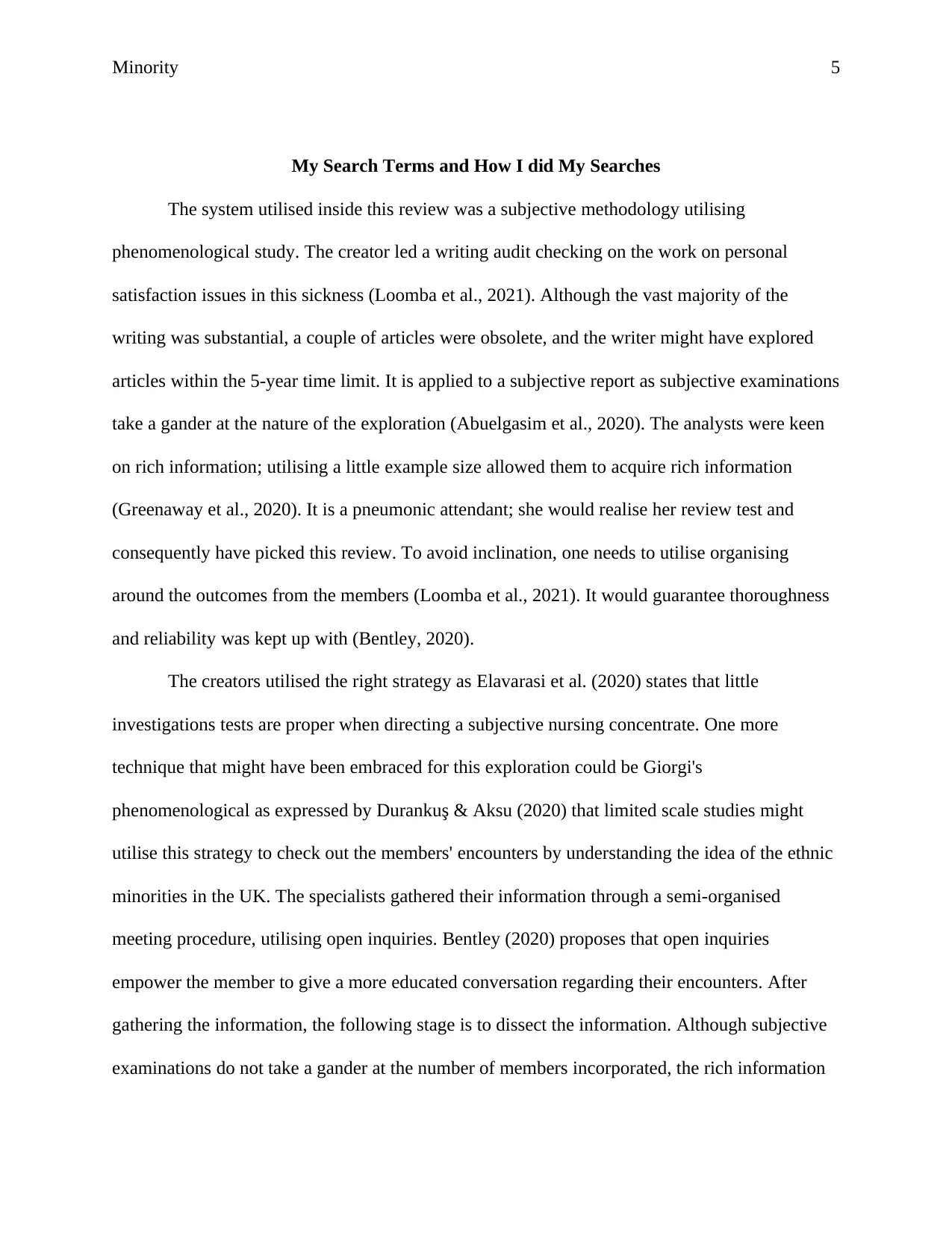
Minority 5
My Search Terms and How I did My Searches
The system utilised inside this review was a subjective methodology utilising
phenomenological study. The creator led a writing audit checking on the work on personal
satisfaction issues in this sickness (Loomba et al., 2021). Although the vast majority of the
writing was substantial, a couple of articles were obsolete, and the writer might have explored
articles within the 5-year time limit. It is applied to a subjective report as subjective examinations
take a gander at the nature of the exploration (Abuelgasim et al., 2020). The analysts were keen
on rich information; utilising a little example size allowed them to acquire rich information
(Greenaway et al., 2020). It is a pneumonic attendant; she would realise her review test and
consequently have picked this review. To avoid inclination, one needs to utilise organising
around the outcomes from the members (Loomba et al., 2021). It would guarantee thoroughness
and reliability was kept up with (Bentley, 2020).
The creators utilised the right strategy as Elavarasi et al. (2020) states that little
investigations tests are proper when directing a subjective nursing concentrate. One more
technique that might have been embraced for this exploration could be Giorgi's
phenomenological as expressed by Durankuş & Aksu (2020) that limited scale studies might
utilise this strategy to check out the members' encounters by understanding the idea of the ethnic
minorities in the UK. The specialists gathered their information through a semi-organised
meeting procedure, utilising open inquiries. Bentley (2020) proposes that open inquiries
empower the member to give a more educated conversation regarding their encounters. After
gathering the information, the following stage is to dissect the information. Although subjective
examinations do not take a gander at the number of members incorporated, the rich information
My Search Terms and How I did My Searches
The system utilised inside this review was a subjective methodology utilising
phenomenological study. The creator led a writing audit checking on the work on personal
satisfaction issues in this sickness (Loomba et al., 2021). Although the vast majority of the
writing was substantial, a couple of articles were obsolete, and the writer might have explored
articles within the 5-year time limit. It is applied to a subjective report as subjective examinations
take a gander at the nature of the exploration (Abuelgasim et al., 2020). The analysts were keen
on rich information; utilising a little example size allowed them to acquire rich information
(Greenaway et al., 2020). It is a pneumonic attendant; she would realise her review test and
consequently have picked this review. To avoid inclination, one needs to utilise organising
around the outcomes from the members (Loomba et al., 2021). It would guarantee thoroughness
and reliability was kept up with (Bentley, 2020).
The creators utilised the right strategy as Elavarasi et al. (2020) states that little
investigations tests are proper when directing a subjective nursing concentrate. One more
technique that might have been embraced for this exploration could be Giorgi's
phenomenological as expressed by Durankuş & Aksu (2020) that limited scale studies might
utilise this strategy to check out the members' encounters by understanding the idea of the ethnic
minorities in the UK. The specialists gathered their information through a semi-organised
meeting procedure, utilising open inquiries. Bentley (2020) proposes that open inquiries
empower the member to give a more educated conversation regarding their encounters. After
gathering the information, the following stage is to dissect the information. Although subjective
examinations do not take a gander at the number of members incorporated, the rich information
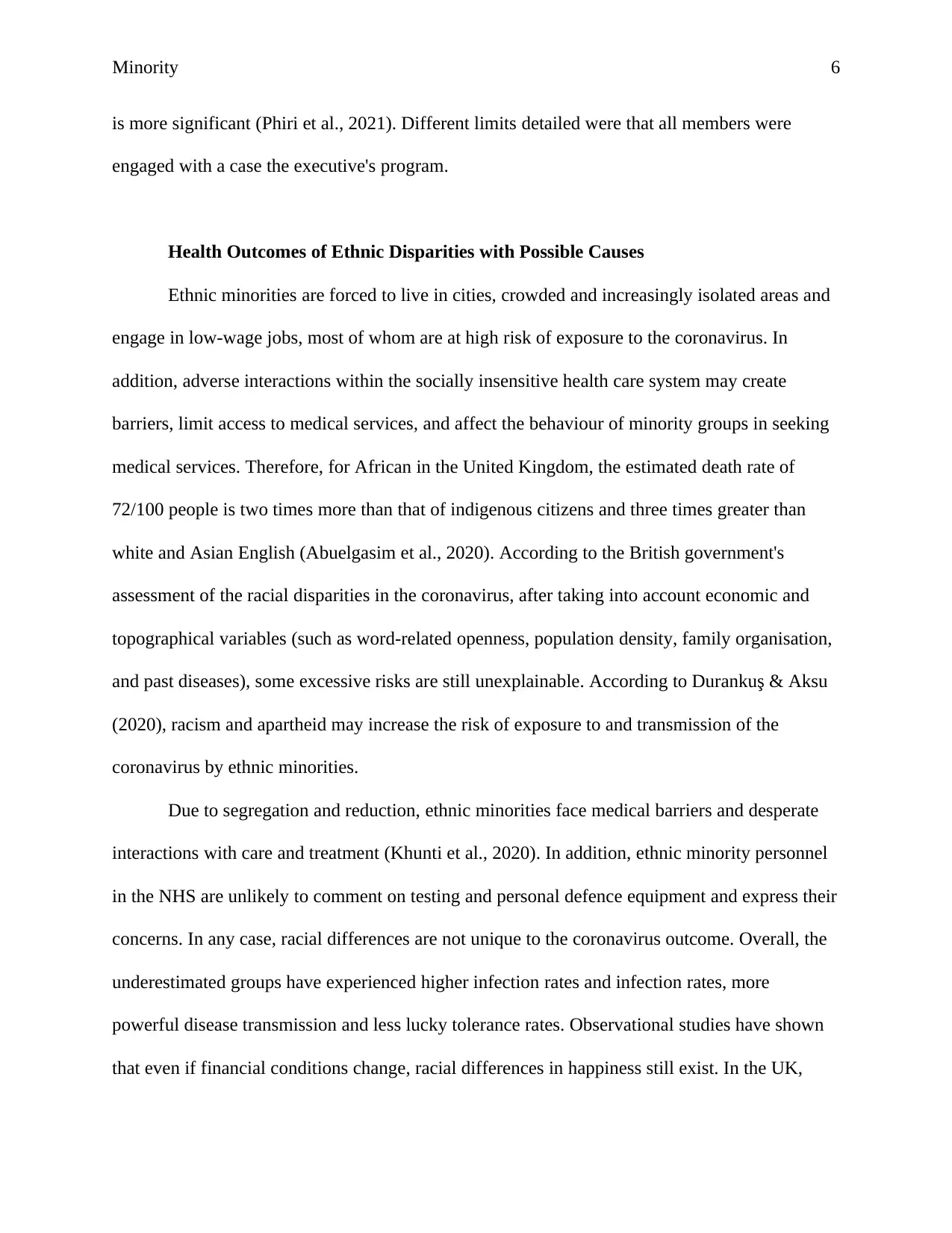
Minority 6
is more significant (Phiri et al., 2021). Different limits detailed were that all members were
engaged with a case the executive's program.
Health Outcomes of Ethnic Disparities with Possible Causes
Ethnic minorities are forced to live in cities, crowded and increasingly isolated areas and
engage in low-wage jobs, most of whom are at high risk of exposure to the coronavirus. In
addition, adverse interactions within the socially insensitive health care system may create
barriers, limit access to medical services, and affect the behaviour of minority groups in seeking
medical services. Therefore, for African in the United Kingdom, the estimated death rate of
72/100 people is two times more than that of indigenous citizens and three times greater than
white and Asian English (Abuelgasim et al., 2020). According to the British government's
assessment of the racial disparities in the coronavirus, after taking into account economic and
topographical variables (such as word-related openness, population density, family organisation,
and past diseases), some excessive risks are still unexplainable. According to Durankuş & Aksu
(2020), racism and apartheid may increase the risk of exposure to and transmission of the
coronavirus by ethnic minorities.
Due to segregation and reduction, ethnic minorities face medical barriers and desperate
interactions with care and treatment (Khunti et al., 2020). In addition, ethnic minority personnel
in the NHS are unlikely to comment on testing and personal defence equipment and express their
concerns. In any case, racial differences are not unique to the coronavirus outcome. Overall, the
underestimated groups have experienced higher infection rates and infection rates, more
powerful disease transmission and less lucky tolerance rates. Observational studies have shown
that even if financial conditions change, racial differences in happiness still exist. In the UK,
is more significant (Phiri et al., 2021). Different limits detailed were that all members were
engaged with a case the executive's program.
Health Outcomes of Ethnic Disparities with Possible Causes
Ethnic minorities are forced to live in cities, crowded and increasingly isolated areas and
engage in low-wage jobs, most of whom are at high risk of exposure to the coronavirus. In
addition, adverse interactions within the socially insensitive health care system may create
barriers, limit access to medical services, and affect the behaviour of minority groups in seeking
medical services. Therefore, for African in the United Kingdom, the estimated death rate of
72/100 people is two times more than that of indigenous citizens and three times greater than
white and Asian English (Abuelgasim et al., 2020). According to the British government's
assessment of the racial disparities in the coronavirus, after taking into account economic and
topographical variables (such as word-related openness, population density, family organisation,
and past diseases), some excessive risks are still unexplainable. According to Durankuş & Aksu
(2020), racism and apartheid may increase the risk of exposure to and transmission of the
coronavirus by ethnic minorities.
Due to segregation and reduction, ethnic minorities face medical barriers and desperate
interactions with care and treatment (Khunti et al., 2020). In addition, ethnic minority personnel
in the NHS are unlikely to comment on testing and personal defence equipment and express their
concerns. In any case, racial differences are not unique to the coronavirus outcome. Overall, the
underestimated groups have experienced higher infection rates and infection rates, more
powerful disease transmission and less lucky tolerance rates. Observational studies have shown
that even if financial conditions change, racial differences in happiness still exist. In the UK,
⊘ This is a preview!⊘
Do you want full access?
Subscribe today to unlock all pages.

Trusted by 1+ million students worldwide
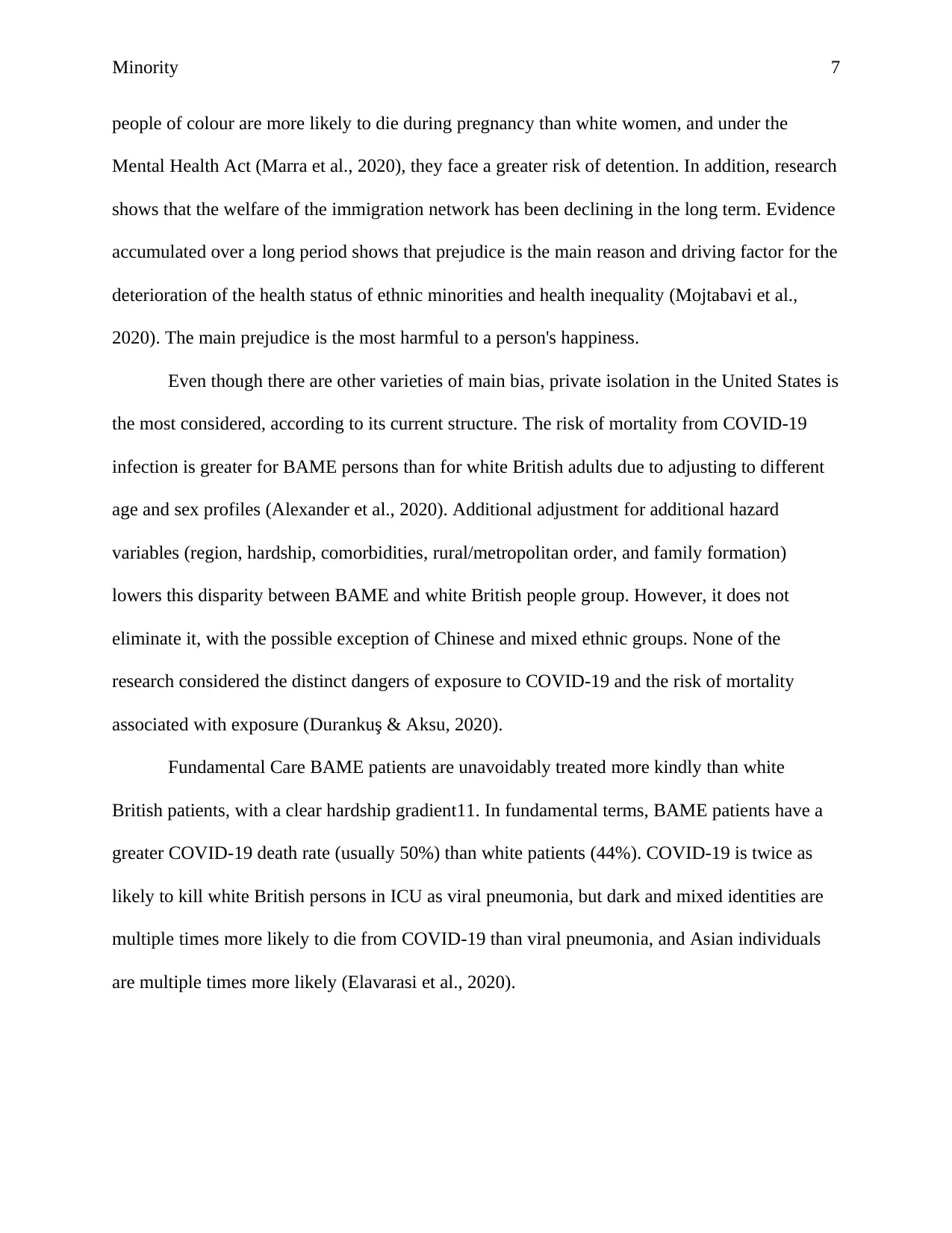
Minority 7
people of colour are more likely to die during pregnancy than white women, and under the
Mental Health Act (Marra et al., 2020), they face a greater risk of detention. In addition, research
shows that the welfare of the immigration network has been declining in the long term. Evidence
accumulated over a long period shows that prejudice is the main reason and driving factor for the
deterioration of the health status of ethnic minorities and health inequality (Mojtabavi et al.,
2020). The main prejudice is the most harmful to a person's happiness.
Even though there are other varieties of main bias, private isolation in the United States is
the most considered, according to its current structure. The risk of mortality from COVID-19
infection is greater for BAME persons than for white British adults due to adjusting to different
age and sex profiles (Alexander et al., 2020). Additional adjustment for additional hazard
variables (region, hardship, comorbidities, rural/metropolitan order, and family formation)
lowers this disparity between BAME and white British people group. However, it does not
eliminate it, with the possible exception of Chinese and mixed ethnic groups. None of the
research considered the distinct dangers of exposure to COVID-19 and the risk of mortality
associated with exposure (Durankuş & Aksu, 2020).
Fundamental Care BAME patients are unavoidably treated more kindly than white
British patients, with a clear hardship gradient11. In fundamental terms, BAME patients have a
greater COVID-19 death rate (usually 50%) than white patients (44%). COVID-19 is twice as
likely to kill white British persons in ICU as viral pneumonia, but dark and mixed identities are
multiple times more likely to die from COVID-19 than viral pneumonia, and Asian individuals
are multiple times more likely (Elavarasi et al., 2020).
people of colour are more likely to die during pregnancy than white women, and under the
Mental Health Act (Marra et al., 2020), they face a greater risk of detention. In addition, research
shows that the welfare of the immigration network has been declining in the long term. Evidence
accumulated over a long period shows that prejudice is the main reason and driving factor for the
deterioration of the health status of ethnic minorities and health inequality (Mojtabavi et al.,
2020). The main prejudice is the most harmful to a person's happiness.
Even though there are other varieties of main bias, private isolation in the United States is
the most considered, according to its current structure. The risk of mortality from COVID-19
infection is greater for BAME persons than for white British adults due to adjusting to different
age and sex profiles (Alexander et al., 2020). Additional adjustment for additional hazard
variables (region, hardship, comorbidities, rural/metropolitan order, and family formation)
lowers this disparity between BAME and white British people group. However, it does not
eliminate it, with the possible exception of Chinese and mixed ethnic groups. None of the
research considered the distinct dangers of exposure to COVID-19 and the risk of mortality
associated with exposure (Durankuş & Aksu, 2020).
Fundamental Care BAME patients are unavoidably treated more kindly than white
British patients, with a clear hardship gradient11. In fundamental terms, BAME patients have a
greater COVID-19 death rate (usually 50%) than white patients (44%). COVID-19 is twice as
likely to kill white British persons in ICU as viral pneumonia, but dark and mixed identities are
multiple times more likely to die from COVID-19 than viral pneumonia, and Asian individuals
are multiple times more likely (Elavarasi et al., 2020).
Paraphrase This Document
Need a fresh take? Get an instant paraphrase of this document with our AI Paraphraser
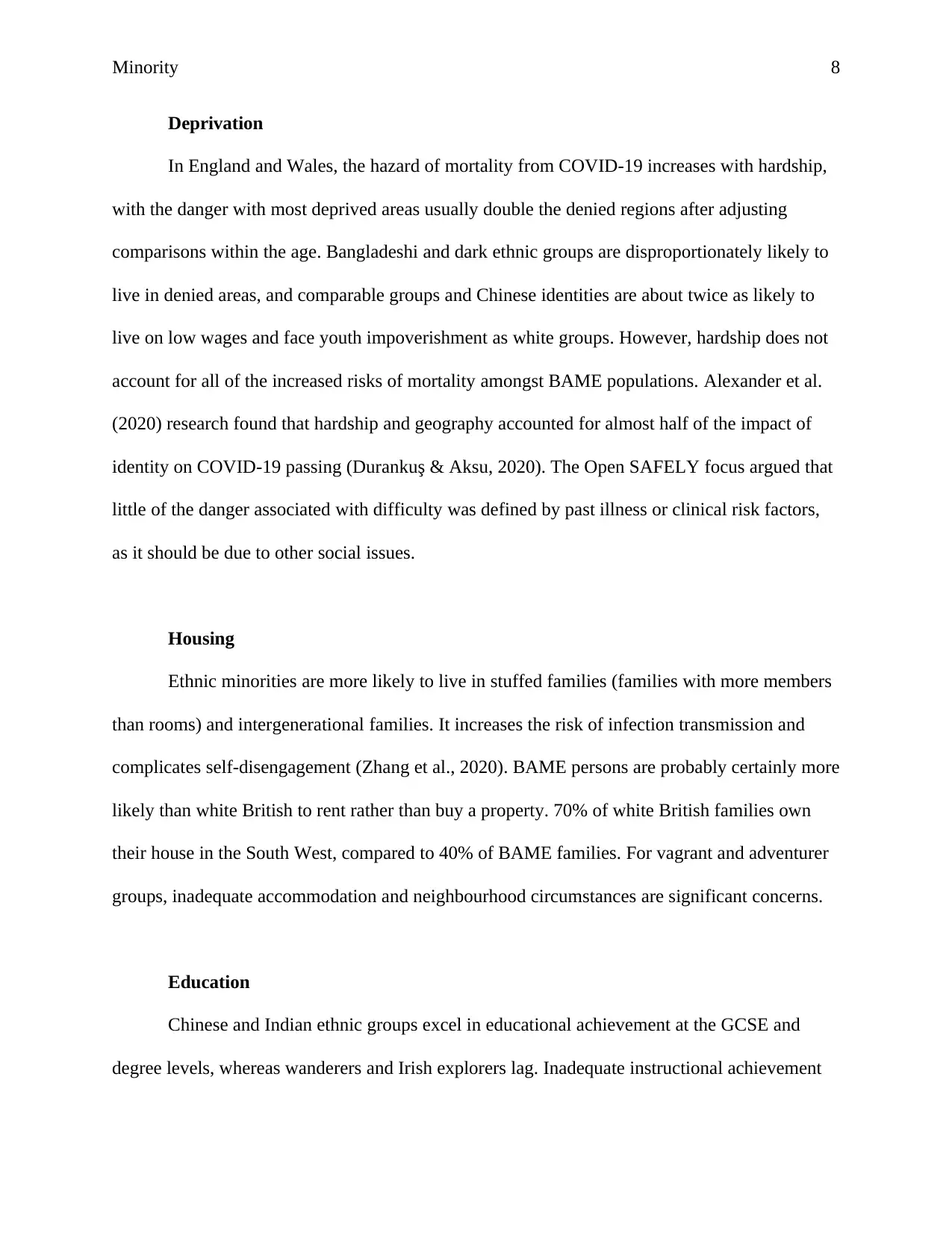
Minority 8
Deprivation
In England and Wales, the hazard of mortality from COVID-19 increases with hardship,
with the danger with most deprived areas usually double the denied regions after adjusting
comparisons within the age. Bangladeshi and dark ethnic groups are disproportionately likely to
live in denied areas, and comparable groups and Chinese identities are about twice as likely to
live on low wages and face youth impoverishment as white groups. However, hardship does not
account for all of the increased risks of mortality amongst BAME populations. Alexander et al.
(2020) research found that hardship and geography accounted for almost half of the impact of
identity on COVID-19 passing (Durankuş & Aksu, 2020). The Open SAFELY focus argued that
little of the danger associated with difficulty was defined by past illness or clinical risk factors,
as it should be due to other social issues.
Housing
Ethnic minorities are more likely to live in stuffed families (families with more members
than rooms) and intergenerational families. It increases the risk of infection transmission and
complicates self-disengagement (Zhang et al., 2020). BAME persons are probably certainly more
likely than white British to rent rather than buy a property. 70% of white British families own
their house in the South West, compared to 40% of BAME families. For vagrant and adventurer
groups, inadequate accommodation and neighbourhood circumstances are significant concerns.
Education
Chinese and Indian ethnic groups excel in educational achievement at the GCSE and
degree levels, whereas wanderers and Irish explorers lag. Inadequate instructional achievement
Deprivation
In England and Wales, the hazard of mortality from COVID-19 increases with hardship,
with the danger with most deprived areas usually double the denied regions after adjusting
comparisons within the age. Bangladeshi and dark ethnic groups are disproportionately likely to
live in denied areas, and comparable groups and Chinese identities are about twice as likely to
live on low wages and face youth impoverishment as white groups. However, hardship does not
account for all of the increased risks of mortality amongst BAME populations. Alexander et al.
(2020) research found that hardship and geography accounted for almost half of the impact of
identity on COVID-19 passing (Durankuş & Aksu, 2020). The Open SAFELY focus argued that
little of the danger associated with difficulty was defined by past illness or clinical risk factors,
as it should be due to other social issues.
Housing
Ethnic minorities are more likely to live in stuffed families (families with more members
than rooms) and intergenerational families. It increases the risk of infection transmission and
complicates self-disengagement (Zhang et al., 2020). BAME persons are probably certainly more
likely than white British to rent rather than buy a property. 70% of white British families own
their house in the South West, compared to 40% of BAME families. For vagrant and adventurer
groups, inadequate accommodation and neighbourhood circumstances are significant concerns.
Education
Chinese and Indian ethnic groups excel in educational achievement at the GCSE and
degree levels, whereas wanderers and Irish explorers lag. Inadequate instructional achievement
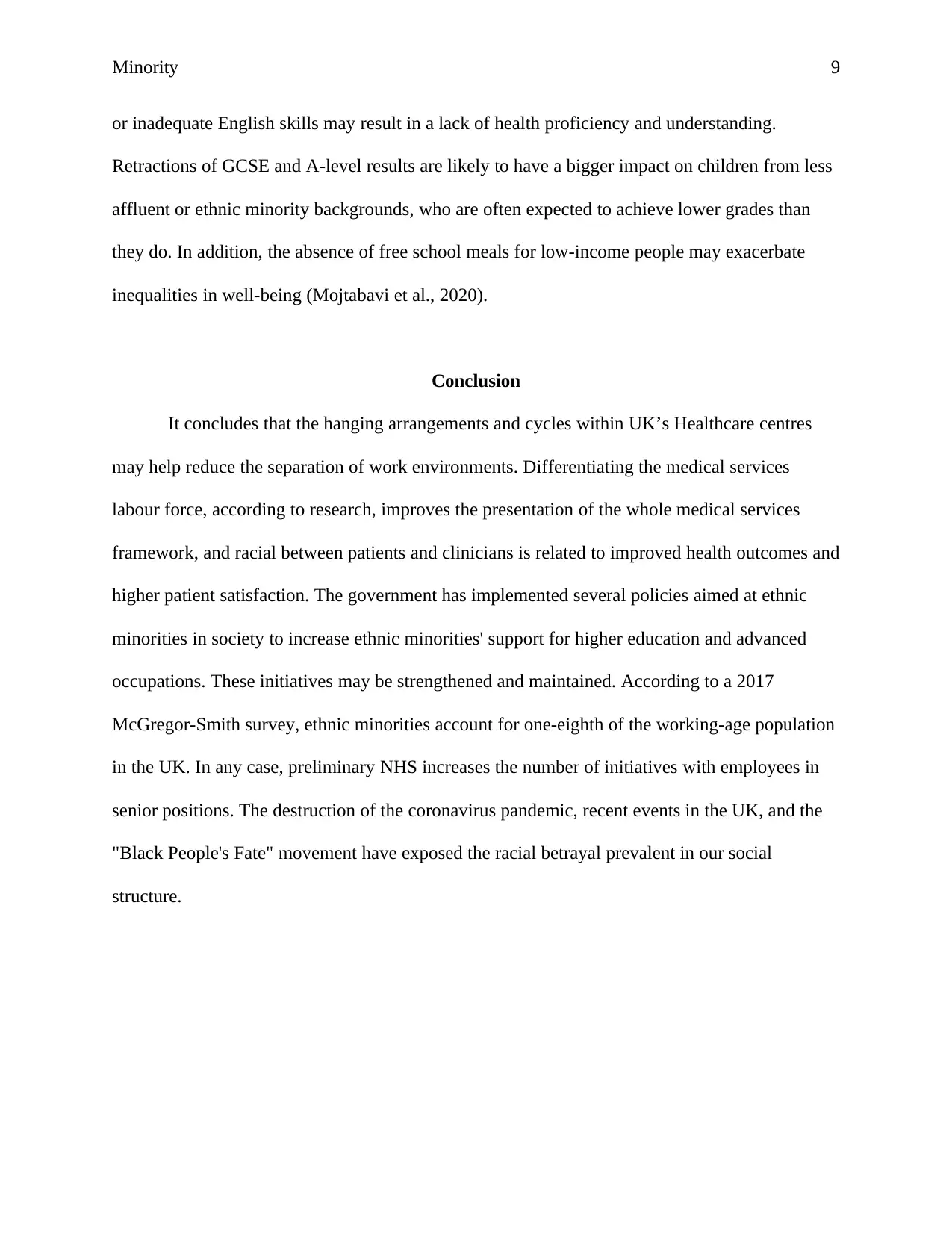
Minority 9
or inadequate English skills may result in a lack of health proficiency and understanding.
Retractions of GCSE and A-level results are likely to have a bigger impact on children from less
affluent or ethnic minority backgrounds, who are often expected to achieve lower grades than
they do. In addition, the absence of free school meals for low-income people may exacerbate
inequalities in well-being (Mojtabavi et al., 2020).
Conclusion
It concludes that the hanging arrangements and cycles within UK’s Healthcare centres
may help reduce the separation of work environments. Differentiating the medical services
labour force, according to research, improves the presentation of the whole medical services
framework, and racial between patients and clinicians is related to improved health outcomes and
higher patient satisfaction. The government has implemented several policies aimed at ethnic
minorities in society to increase ethnic minorities' support for higher education and advanced
occupations. These initiatives may be strengthened and maintained. According to a 2017
McGregor-Smith survey, ethnic minorities account for one-eighth of the working-age population
in the UK. In any case, preliminary NHS increases the number of initiatives with employees in
senior positions. The destruction of the coronavirus pandemic, recent events in the UK, and the
"Black People's Fate" movement have exposed the racial betrayal prevalent in our social
structure.
or inadequate English skills may result in a lack of health proficiency and understanding.
Retractions of GCSE and A-level results are likely to have a bigger impact on children from less
affluent or ethnic minority backgrounds, who are often expected to achieve lower grades than
they do. In addition, the absence of free school meals for low-income people may exacerbate
inequalities in well-being (Mojtabavi et al., 2020).
Conclusion
It concludes that the hanging arrangements and cycles within UK’s Healthcare centres
may help reduce the separation of work environments. Differentiating the medical services
labour force, according to research, improves the presentation of the whole medical services
framework, and racial between patients and clinicians is related to improved health outcomes and
higher patient satisfaction. The government has implemented several policies aimed at ethnic
minorities in society to increase ethnic minorities' support for higher education and advanced
occupations. These initiatives may be strengthened and maintained. According to a 2017
McGregor-Smith survey, ethnic minorities account for one-eighth of the working-age population
in the UK. In any case, preliminary NHS increases the number of initiatives with employees in
senior positions. The destruction of the coronavirus pandemic, recent events in the UK, and the
"Black People's Fate" movement have exposed the racial betrayal prevalent in our social
structure.
⊘ This is a preview!⊘
Do you want full access?
Subscribe today to unlock all pages.

Trusted by 1+ million students worldwide
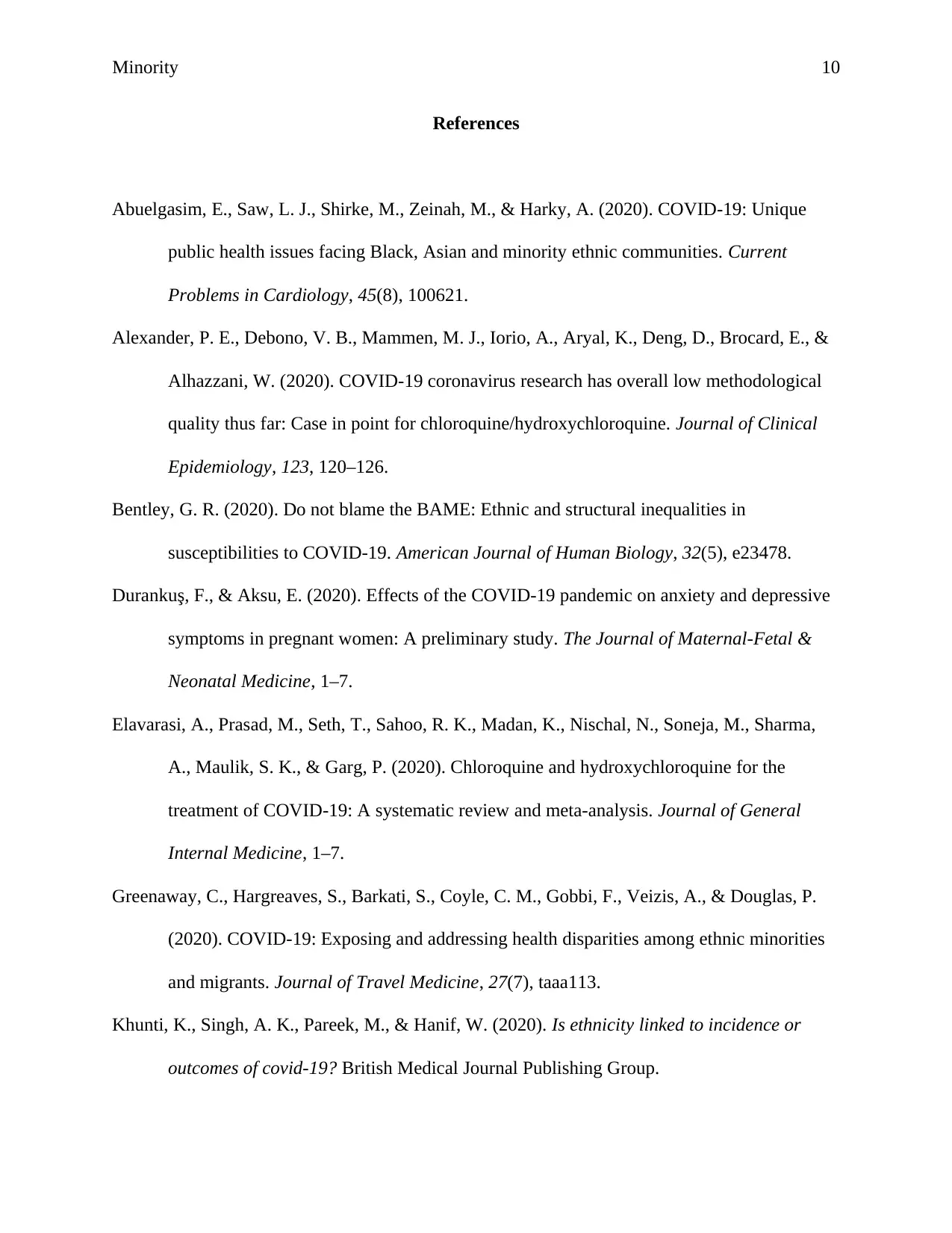
Minority 10
References
Abuelgasim, E., Saw, L. J., Shirke, M., Zeinah, M., & Harky, A. (2020). COVID-19: Unique
public health issues facing Black, Asian and minority ethnic communities. Current
Problems in Cardiology, 45(8), 100621.
Alexander, P. E., Debono, V. B., Mammen, M. J., Iorio, A., Aryal, K., Deng, D., Brocard, E., &
Alhazzani, W. (2020). COVID-19 coronavirus research has overall low methodological
quality thus far: Case in point for chloroquine/hydroxychloroquine. Journal of Clinical
Epidemiology, 123, 120–126.
Bentley, G. R. (2020). Do not blame the BAME: Ethnic and structural inequalities in
susceptibilities to COVID-19. American Journal of Human Biology, 32(5), e23478.
Durankuş, F., & Aksu, E. (2020). Effects of the COVID-19 pandemic on anxiety and depressive
symptoms in pregnant women: A preliminary study. The Journal of Maternal-Fetal &
Neonatal Medicine, 1–7.
Elavarasi, A., Prasad, M., Seth, T., Sahoo, R. K., Madan, K., Nischal, N., Soneja, M., Sharma,
A., Maulik, S. K., & Garg, P. (2020). Chloroquine and hydroxychloroquine for the
treatment of COVID-19: A systematic review and meta-analysis. Journal of General
Internal Medicine, 1–7.
Greenaway, C., Hargreaves, S., Barkati, S., Coyle, C. M., Gobbi, F., Veizis, A., & Douglas, P.
(2020). COVID-19: Exposing and addressing health disparities among ethnic minorities
and migrants. Journal of Travel Medicine, 27(7), taaa113.
Khunti, K., Singh, A. K., Pareek, M., & Hanif, W. (2020). Is ethnicity linked to incidence or
outcomes of covid-19? British Medical Journal Publishing Group.
References
Abuelgasim, E., Saw, L. J., Shirke, M., Zeinah, M., & Harky, A. (2020). COVID-19: Unique
public health issues facing Black, Asian and minority ethnic communities. Current
Problems in Cardiology, 45(8), 100621.
Alexander, P. E., Debono, V. B., Mammen, M. J., Iorio, A., Aryal, K., Deng, D., Brocard, E., &
Alhazzani, W. (2020). COVID-19 coronavirus research has overall low methodological
quality thus far: Case in point for chloroquine/hydroxychloroquine. Journal of Clinical
Epidemiology, 123, 120–126.
Bentley, G. R. (2020). Do not blame the BAME: Ethnic and structural inequalities in
susceptibilities to COVID-19. American Journal of Human Biology, 32(5), e23478.
Durankuş, F., & Aksu, E. (2020). Effects of the COVID-19 pandemic on anxiety and depressive
symptoms in pregnant women: A preliminary study. The Journal of Maternal-Fetal &
Neonatal Medicine, 1–7.
Elavarasi, A., Prasad, M., Seth, T., Sahoo, R. K., Madan, K., Nischal, N., Soneja, M., Sharma,
A., Maulik, S. K., & Garg, P. (2020). Chloroquine and hydroxychloroquine for the
treatment of COVID-19: A systematic review and meta-analysis. Journal of General
Internal Medicine, 1–7.
Greenaway, C., Hargreaves, S., Barkati, S., Coyle, C. M., Gobbi, F., Veizis, A., & Douglas, P.
(2020). COVID-19: Exposing and addressing health disparities among ethnic minorities
and migrants. Journal of Travel Medicine, 27(7), taaa113.
Khunti, K., Singh, A. K., Pareek, M., & Hanif, W. (2020). Is ethnicity linked to incidence or
outcomes of covid-19? British Medical Journal Publishing Group.
Paraphrase This Document
Need a fresh take? Get an instant paraphrase of this document with our AI Paraphraser
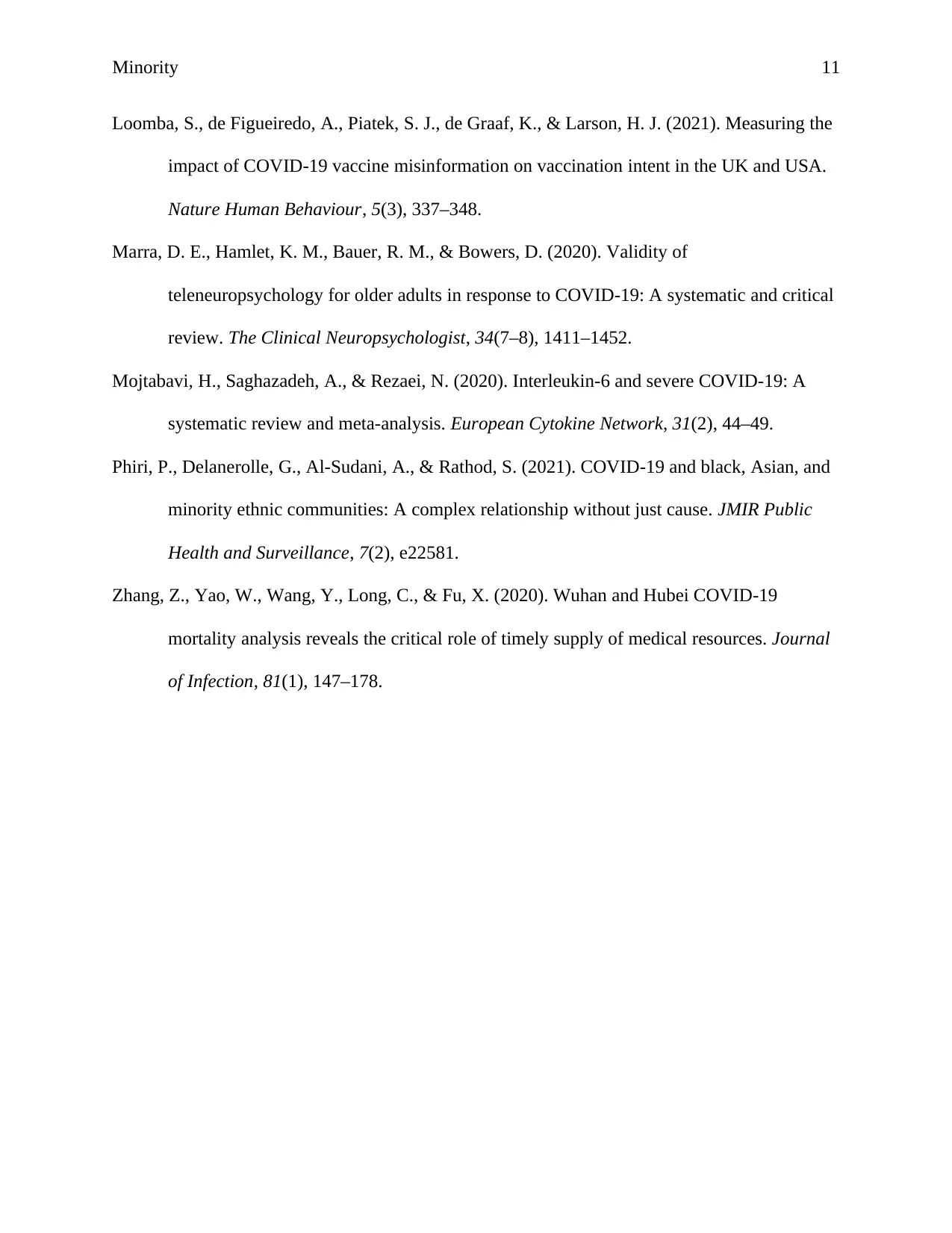
Minority 11
Loomba, S., de Figueiredo, A., Piatek, S. J., de Graaf, K., & Larson, H. J. (2021). Measuring the
impact of COVID-19 vaccine misinformation on vaccination intent in the UK and USA.
Nature Human Behaviour, 5(3), 337–348.
Marra, D. E., Hamlet, K. M., Bauer, R. M., & Bowers, D. (2020). Validity of
teleneuropsychology for older adults in response to COVID-19: A systematic and critical
review. The Clinical Neuropsychologist, 34(7–8), 1411–1452.
Mojtabavi, H., Saghazadeh, A., & Rezaei, N. (2020). Interleukin-6 and severe COVID-19: A
systematic review and meta-analysis. European Cytokine Network, 31(2), 44–49.
Phiri, P., Delanerolle, G., Al-Sudani, A., & Rathod, S. (2021). COVID-19 and black, Asian, and
minority ethnic communities: A complex relationship without just cause. JMIR Public
Health and Surveillance, 7(2), e22581.
Zhang, Z., Yao, W., Wang, Y., Long, C., & Fu, X. (2020). Wuhan and Hubei COVID-19
mortality analysis reveals the critical role of timely supply of medical resources. Journal
of Infection, 81(1), 147–178.
Loomba, S., de Figueiredo, A., Piatek, S. J., de Graaf, K., & Larson, H. J. (2021). Measuring the
impact of COVID-19 vaccine misinformation on vaccination intent in the UK and USA.
Nature Human Behaviour, 5(3), 337–348.
Marra, D. E., Hamlet, K. M., Bauer, R. M., & Bowers, D. (2020). Validity of
teleneuropsychology for older adults in response to COVID-19: A systematic and critical
review. The Clinical Neuropsychologist, 34(7–8), 1411–1452.
Mojtabavi, H., Saghazadeh, A., & Rezaei, N. (2020). Interleukin-6 and severe COVID-19: A
systematic review and meta-analysis. European Cytokine Network, 31(2), 44–49.
Phiri, P., Delanerolle, G., Al-Sudani, A., & Rathod, S. (2021). COVID-19 and black, Asian, and
minority ethnic communities: A complex relationship without just cause. JMIR Public
Health and Surveillance, 7(2), e22581.
Zhang, Z., Yao, W., Wang, Y., Long, C., & Fu, X. (2020). Wuhan and Hubei COVID-19
mortality analysis reveals the critical role of timely supply of medical resources. Journal
of Infection, 81(1), 147–178.
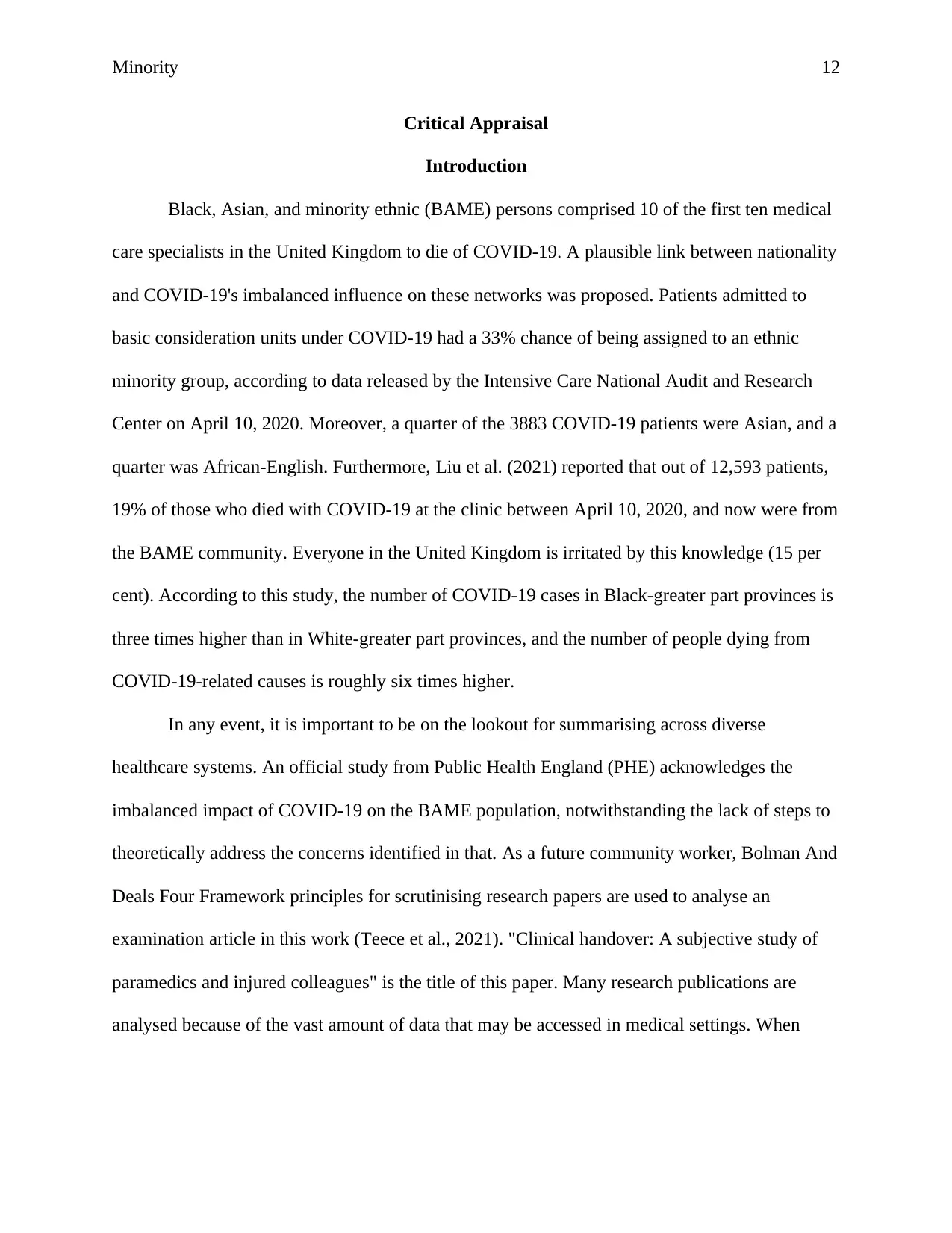
Minority 12
Critical Appraisal
Introduction
Black, Asian, and minority ethnic (BAME) persons comprised 10 of the first ten medical
care specialists in the United Kingdom to die of COVID-19. A plausible link between nationality
and COVID-19's imbalanced influence on these networks was proposed. Patients admitted to
basic consideration units under COVID-19 had a 33% chance of being assigned to an ethnic
minority group, according to data released by the Intensive Care National Audit and Research
Center on April 10, 2020. Moreover, a quarter of the 3883 COVID-19 patients were Asian, and a
quarter was African-English. Furthermore, Liu et al. (2021) reported that out of 12,593 patients,
19% of those who died with COVID-19 at the clinic between April 10, 2020, and now were from
the BAME community. Everyone in the United Kingdom is irritated by this knowledge (15 per
cent). According to this study, the number of COVID-19 cases in Black-greater part provinces is
three times higher than in White-greater part provinces, and the number of people dying from
COVID-19-related causes is roughly six times higher.
In any event, it is important to be on the lookout for summarising across diverse
healthcare systems. An official study from Public Health England (PHE) acknowledges the
imbalanced impact of COVID-19 on the BAME population, notwithstanding the lack of steps to
theoretically address the concerns identified in that. As a future community worker, Bolman And
Deals Four Framework principles for scrutinising research papers are used to analyse an
examination article in this work (Teece et al., 2021). "Clinical handover: A subjective study of
paramedics and injured colleagues" is the title of this paper. Many research publications are
analysed because of the vast amount of data that may be accessed in medical settings. When
Critical Appraisal
Introduction
Black, Asian, and minority ethnic (BAME) persons comprised 10 of the first ten medical
care specialists in the United Kingdom to die of COVID-19. A plausible link between nationality
and COVID-19's imbalanced influence on these networks was proposed. Patients admitted to
basic consideration units under COVID-19 had a 33% chance of being assigned to an ethnic
minority group, according to data released by the Intensive Care National Audit and Research
Center on April 10, 2020. Moreover, a quarter of the 3883 COVID-19 patients were Asian, and a
quarter was African-English. Furthermore, Liu et al. (2021) reported that out of 12,593 patients,
19% of those who died with COVID-19 at the clinic between April 10, 2020, and now were from
the BAME community. Everyone in the United Kingdom is irritated by this knowledge (15 per
cent). According to this study, the number of COVID-19 cases in Black-greater part provinces is
three times higher than in White-greater part provinces, and the number of people dying from
COVID-19-related causes is roughly six times higher.
In any event, it is important to be on the lookout for summarising across diverse
healthcare systems. An official study from Public Health England (PHE) acknowledges the
imbalanced impact of COVID-19 on the BAME population, notwithstanding the lack of steps to
theoretically address the concerns identified in that. As a future community worker, Bolman And
Deals Four Framework principles for scrutinising research papers are used to analyse an
examination article in this work (Teece et al., 2021). "Clinical handover: A subjective study of
paramedics and injured colleagues" is the title of this paper. Many research publications are
analysed because of the vast amount of data that may be accessed in medical settings. When
⊘ This is a preview!⊘
Do you want full access?
Subscribe today to unlock all pages.

Trusted by 1+ million students worldwide
1 out of 20
Your All-in-One AI-Powered Toolkit for Academic Success.
+13062052269
info@desklib.com
Available 24*7 on WhatsApp / Email
![[object Object]](/_next/static/media/star-bottom.7253800d.svg)
Unlock your academic potential
Copyright © 2020–2025 A2Z Services. All Rights Reserved. Developed and managed by ZUCOL.


